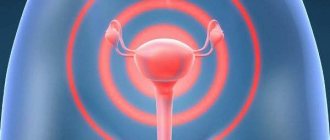Main symptoms
Uterine bleeding in a “special position,” especially at its very beginning, is not a normal phenomenon. In some cases, it may have natural causes and not pose a threat to the woman and the fetus, and sometimes it is a serious pathology that can be fatal not only to the unborn child.
Therefore, a woman should clearly know the symptoms of this condition and, if any of them occur, immediately seek help.
Even minor pinkish or brownish discharge is considered bleeding during pregnancy. They may be light in color, with small streaks of blood.
The discharge may be light or dark brown in color. And they all indicate that something is happening in the reproductive system and you should be wary. Among other things, the discharge may be similar to menstruation both in consistency and quantity.
In addition to blood released from the genital tract, a woman may experience pain in the lower abdomen or lower back. The intensity of the pain can be different - either barely noticeable, like during menstruation, or very strong. Also, in some cases, the temperature may rise.
What is Tranexam
Tranexam belongs to the hemostatic and antifibrinolytic pharmacological groups of drugs. That is, it is able to prevent and stop bleeding by thickening the blood and enhancing its coagulability. In addition, the drug has pronounced anti-inflammatory, anti-edematous, antispasmodic and analgesic effects. The instructions also state that Tranexam has antiallergic, antitumor and anti-infective effects.
The active component of the drug is tranexamic acid, synthesized in 1962. It is an isomeric form of aminocaproic acid, which is also “famous” for its ability to stop bleeding. Only, unlike tranexamic acid, it exhibits lower antifibrinolytic activity, and besides, it is prohibited during pregnancy.
Tranexamic acid, the active ingredient of the drug, is approved for use for bleeding during pregnancy
It is known that Tranexam has the ability to penetrate the placenta. Therefore, it is not prescribed to everyone, but only in cases of urgent need.
American health agency for control of food safety, cosmetics, drugs, etc. (FDA) classified Tranexam in category "B". That is, preclinical studies conducted on laboratory animals did not reveal any negative effects on the development and growth of the fetus. But there have been no proper tests on pregnant women.
In pharmacies, Tranexam can be found in two forms: tablets and solution.
Tranexam in tablet form
Tablets can be found with a dosage of the active substance of 250 or 500 mg. Each tablet has a biconvex shape and is coated with a white coating. On the fault, the internal contents are dense, white, grayish or cream in color. Tablets are produced in ten pieces in contour cells, which, in turn, are packed in cardboard boxes. Each box contains one, two, three, four or five contour cells.
The minimum cost of tablets with a dosage of 250 mg is 250 rubles, tablets of 500 mg - 370 rubles.
Tranexam in tablet form is most often prescribed to pregnant women.
Tranexam in solution form
Tranexam solution is produced in five-milliliter glass ampoules placed in contour cells, which, in turn, are located in cardboard packages. Each cardboard package contains one or two contour cells. The solution is transparent (or with a brownish tint), colorless and without any impurities. One milliliter of the drug contains 50 or 100 mg of the active ingredient - tranexamic acid. Special water for injection acts as an excipient.
The minimum cost of a package of Tranexam in the form of a solution with a dosage of 50 mg/ml is 1280 rubles, with a dosage of 100 mg/ml - 1460 rubles.
Tranexam in solution form is most often used in hospital treatment
Main causes of bleeding
There are several reasons why bleeding occurs during early pregnancy. Some of them do not pose a threat, although they are a deviation from the norm, while others are life-threatening.
The main causes of blood loss in an “interesting position”:
- implantation bleeding;
- menstruation through the fetus;
- miscarriage;
- problems with the placenta;
- frozen and ectopic pregnancy.
Why does bleeding occur?
Implantation processes for the introduction of the fertilized egg into the endometrium. At a time when you might have expected the next onset of your cycle, which did not occur due to pregnancy, you may observe slight bleeding on your underwear for a couple of days. Their color is mostly bright, like that of arterial blood.
The so-called menstruation through the fetus. In fact, there can be no talk of any menstruation during an “interesting situation”, because these processes are mutually exclusive.
However, this phenomenon is observed and has several reasons. Blood appears on the same days when menstruation was planned. It may be slightly less, and the pain may be more dull.
This happens due to the fact that there is still insufficient amount of progesterone in the pregnant woman’s body; the body has not yet had time to “understand” its new state and “out of habit” has started the monthly process.
If the reason for the blood that appears during pregnancy in the early stages is a lack of hormones, then “menstruation” through the fetus can continue until the formation of the placenta, until it takes over the production of hormones.
However, it is better to consult a doctor, since hormonal imbalance and lack of progesterone can cause spontaneous abortion.
Another reason for “pregnant periods” is the simultaneous maturation and fertilization of two eggs.
While one egg has successfully implanted into the uterine wall and is preparing to develop, the other is rejected by the endometrium. So we get bleeding in the early stages. But this is where the safe reasons for the appearance of blood in an “interesting position” end.
Miscarriage is the main cause of uterine blood loss early in pregnancy. There appears copious blood from the genital tract, dark clots and quite severe cramping pain in the lower abdomen.
In most cases, miscarriage is caused by pathologies in the development of the fetus. Sometimes the reason is a lack of pregnancy hormones, which should preserve it.
The appearance of blood in the fifth week may indicate an Rh conflict between mother and child, because it is at this time that the circulatory system is formed in the embryo.
Frozen pregnancy. In this case, the embryo simply stops developing, dying inside the mother. For some time there may be no symptoms at all, and the condition can only be determined by a doctor during examination using an ultrasound.
But sometimes the condition can be accompanied by a decrease in the volume of the mammary glands, abdominal pain and scanty bleeding.
An ectopic pregnancy is accompanied by symptoms similar to those of a miscarriage. The difference may be in the localization of pain in only one part of the abdomen. Blood begins to flow around the sixth week.
The pain is intense, nausea and weakness may occur. The condition threatens massive internal bleeding due to rupture of the fallopian tube.
How to determine the exact cause
To diagnose the exact cause of the resulting blood loss, the following studies are required:
- examination by a gynecologist;
- general analysis of urine and blood;
- smear analysis;
- blood tests for hepatitis, syphilis and HIV;
- intravaginal ultrasound of the pelvic organs and fetus;
- analysis for blood group and Rh factor;
- hormone analysis;
- hCG level analysis;
- If an ectopic pregnancy is suspected, laparoscopy may be prescribed.
Contraindications for Tranexam
A pregnant woman should not take the drug in the following cases:
- With thrombosis.
- At .
- If the blood supply to the brain is impaired.
The drug should not be used intravenously if the pregnant woman has received transfusions. Also, you cannot combine this medication with Diazepam or drugs from the Tetracycline group, otherwise thrombosis may develop. After 3 hours, the maximum concentration of the drug can be detected in the blood.
Attention! Tranexam is excreted by the renal system, so this drug cannot be used for diseases of the urinary system, because it accumulates in the body.
Thus, Tranexam is prescribed to a pregnant woman in case of a threatened miscarriage. Additionally, the drug is used to relieve allergic reactions and also as an anti-inflammatory agent. The medicine must not be taken uncontrolled, otherwise it can lead to serious consequences. If your condition suddenly worsens or you experience bleeding, call an ambulance immediately. Every minute is valuable here. If the bleeding is stopped in a timely manner, the baby can be saved. You won't be able to do this on your own. Remember that it is easier to prevent a miscarriage, so do not overwork, avoid stress, relax and enjoy life. Take care of yourself and your baby!
Currently, an increasing number of women are faced with the threat of early pregnancy termination. There are many reasons that can lead to early loss of a child. This may be due to a changed lifestyle, lack of progesterone, stress, excessive nervous tension, poor diet, bad habits, and sometimes this problem is associated with the general condition of the woman’s body and her individual characteristics.
Any expectant mother wants to enjoy her pregnancy and experience joy from her condition, but, unfortunately, everything does not always turn out as rosy as we would like. When there is a threat of miscarriage, symptoms such as bloody discharge from the genitals and nagging pain in the lower abdomen appear. In this case, during a routine examination, the doctor may prescribe drug treatment aimed at maintaining the pregnancy. One of the drugs that doctors prescribe is Tranexam.
Tranexam is a drug that has anti-inflammatory and hemostatic effects. The main active component of the drug is tranexamic acid. Drug therapy is aimed at stopping bleeding. The drug makes the blood thicker and enhances its clotting. All this helps to maintain pregnancy in the first weeks of its development. In addition, with long-term use, a pronounced analgesic effect is observed, thanks to which the drug can not only stop bleeding, but also eliminate pain in the abdomen and lower back. Tranexam is also prescribed during early pregnancy to prevent the threat of miscarriage.
How to stop bleeding at home: tablets and folk remedies
Of course, in these emergency circumstances, the first thing to do is to seek medical help and consult a specialist.
But if it is not possible to call an ambulance, if a visit to a doctor is impossible, the woman needs to know the list of hemostatic agents that can be used in this condition.
For minor blood loss
Minor bleeding may have natural causes and therefore does not require special medications. Sometimes it is enough to get by with some folk remedies.
- water pepper extract - promotes blood clotting and stops blood loss;
- Lagochilus tincture - increases the rate of blood clotting;
- calcium chloride - administered intravenously and contains calcium, which is involved in the coagulation process;
- “Vikasol” or vitamin K is a substance necessary for the liver to synthesize proteins that promote blood clotting. Release form - both in injections and tablets;
- "Dicinon" in the form of hemostatic tablets stops blood loss approximately three hours after administration.
How to take Tranexam: dosage
During pregnancy, you should take this drug 1-2 tablets 3-4 times a day after meals. The full course of treatment usually lasts several weeks. If necessary, the course of treatment can be extended. The correct dosage is prescribed by the doctor, taking into account all the nuances of the pregnancy. You should not self-medicate and take pills at your own discretion.
There is a dosage table based on which the doctor makes prescriptions
:
- In case of hematoma, uterine or nosebleeds, during pregnancy, 1000-1500 mg is prescribed several times a day.
- In the early stages, to stop bleeding, the dose is 250-500 mg 4 times a day for a week.
- For allergies and inflammation, Tranexamic acid is taken 2 times over 24 hours, 1000-1500 mg.
- When generalized fibrinolysis is established, a Tranexam drip is placed, followed by 1000 mg tablets several times a day.
Most often, Tranexam is prescribed in tablets, but in certain cases the doctor may decide to take the drug in a solution that is administered intravenously. In cases where blood loss reaches more than 100 ml, a dropper is prescribed, followed by switching to tablets. The dropper is prescribed in the following dosages: for generalized fibrinolysis, 15 mg per kg of the pregnant woman every 6 hours; for local fibrinolysis, the drug is administered no more than 500 mg 2 times a day.
Prevention
Any preventive measures should begin with preparation for conception. The expectant mother must undergo a full examination at the clinic, cure all infections and diseases of the reproductive system, and exclude serious pathologies in the structure of the pelvic organs.
A pregnant woman should avoid stress and be in a good emotional state. Walking in the fresh air, a calm rhythm of life, a healthy diet, giving up all bad habits, only friendly communication, gymnastics for pregnant women, following the recommendations of your gynecologist - these are the conditions for the well-being of an “interesting situation.”
Pregnancy is a difficult stage in a woman's life. A radical restructuring occurs in the body. Bleeding during early pregnancy is a deviation and requires consultation with a doctor. This condition is dangerous and can threaten the life of the unborn baby.
- The best hemostatic drugs for early pregnancy
- Why does slight bleeding occur?
- What conditions can cause bleeding in the early stages?
- Factors that cause excessive bleeding
- What to do and how to stop bleeding during pregnancy
- Is bleeding dangerous during early pregnancy (video)
Why is Tranexam prescribed?
Modern pharmacology, after conducting various studies, has developed a drug that helps many women prevent miscarriage in the early and late stages. Tranexam is available in the form of tablets or injections. This drug is completely safe for the fetus, as it does not freely penetrate the placenta. According to its pharmaceutical characteristics, this drug is classified as a hemostatic drug. As a rule, the threat of interruption is accompanied by bleeding. During pregnancy, this drug tends to make the blood thicker, which has a good effect on clotting.
Pregnant women are prescribed hemostatic medications in cases:
- The appearance of aching and nagging pain in the lower abdomen;
- When brown vaginal discharge appears;
- For prevention, if a woman has previously had miscarriages or has been diagnosed with “recurrent miscarriage”;
- If inflammatory processes are detected in the body of a pregnant woman;
- If a pregnant woman is prone to allergic reactions;
- With placental abruption.
At the first symptoms of a threat, Tranexam should be taken as early as possible. If there is a threat of miscarriage, taking this drug helps stop bleeding and reduce pain. The drug also has properties to relieve allergic reactions and inflammation of various types. As was previously said, this medicine does not have a negative effect on the fetus, so expectant mothers should not worry about this.
Vilprafen solutab: 17 reasons for taking the drug
The best hemostatic drugs for early pregnancy
Bleeding in early pregnancy comes in different colors and differs in the amount of discharge. May threaten miscarriage or cause illness.
Exacerbation of gynecological diseases or trauma to the uterus becomes the cause of pathology.
To accurately compile a clinical picture, a full examination by a gynecologist and tests are required. Trying to establish the cause on your own or biding your time is an unjustified risk to the life of the mother and child. Timely contact with specialists allows you to deliver a healthy baby in 80% of cases.
If there is an increased risk of losing the fetus, the following hemostatic drugs are prescribed:
- "Papaverine" and "No-shpa" reduce contraction of the uterine walls,
- "Duphaston" normalizes progesterone levels,
- Valerian or Motherwort, a sedative that helps smooth out the muscles of the uterus,
- "Dicinone" promotes the formation of platelets, has a hemostatic effect,
- "Vikasol" begins to act after 8-12 hours, increases blood clotting, is prescribed in complex therapy,
- "Exacil" contains tranexamic acid, promoting blood clotting and allowing you to quickly stop bleeding.
Treatment is supplemented with vitamins E and C, as well as folic acid, to strengthen the walls of blood vessels and improve well-being. You cannot prescribe hemostatic drugs on your own. All medications have side effects. It is necessary to monitor blood viscosity, blood pressure and know the exact cause of bleeding.
If bleeding occurs in the early stages of pregnancy, you must call an ambulance, take a horizontal position with a bolster under your feet, drink No-shpu and wait for the doctor to arrive.
Composition of Tranexam
The drug includes:
- Tranexamic acid.
- Sodium glycolate.
- Microcrystalline cellulose.
- Silica.
In early pregnancy, the gynecologist may prescribe the drug for nagging pain in the lower abdomen and the appearance of bloody discharge. A pregnant woman should take the drug as quickly as possible. Tranexam helps even in the most severe cases:
- If the placenta ages prematurely.
- When detachment of the fertilized egg occurs.
These pathologies are most often discovered after an ultrasound scan.
Why does slight bleeding occur?
Bleeding may not always indicate a threat of miscarriage. There are various conditions in which small amounts of blood are released.
Reasons for small discharge:
- Egg implantation. Small smears may occur during the fertilization process. By attaching to the uterine wall, the embryo damages small vessels.
- In some cases, a small hormonal change has little effect on the onset of menstruation. The body releases a small amount of blood droplets. In this case, nagging pain may be noted.
- Gynecological diseases. Cervical erosion may cause slight discharge. A drop of blood appears due to injured epithelium, during sexual contact or an awkward position of the body. This condition does not pose a danger to the mother and unborn child. Doctors delay treatment until after the baby is born.
- Polyps are able to announce their existence through bloody discharge. In this situation, the blood comes out in scanty drops, without causing pain. In this case, gynecologists choose a wait-and-see approach. Usually the bleeding lesion disappears on its own.
- Varicose veins in the genital area can lead to minor discharge. Increasing uterine pressure affects blood vessels and capillaries, and sexual activity can enhance the negative effect.
- Venereal diseases. Even in an interesting position, a woman is not immune from contracting an infection. Trichomoniasis and chlamydia can cause discharge, accompanied by itching, an unpleasant odor, fever and loss of strength.
There may be many factors that provoke light bleeding, but this is not a reason for an indifferent attitude towards the body in the first weeks of pregnancy.
Instructions for use of Tranexam during pregnancy
The instructions for using this drug are much longer than described above, so before taking it it would be a good idea to read in detail about the rules of administration and possible side effects.
Teopek or Eufillin, which is better: 7 indications during pregnancy and more
In general, the drug is well tolerated, but such adverse reactions are possible:
- Heartburn;
- Nausea;
- Vomiting;
- General weakening of the body;
- The occurrence of dizziness;
- Possible disturbances in the functioning of the visual organs;
- Possible heart palpitations;
- Thrombosis formation;
- Pain in the chest area may occur;
- The appearance of allergic reactions in the form of a small rash, redness of the skin, itching.
Like any medicine, this drug has contraindications for use. Pregnant women should not take the drug if: a diagnosis of varicose veins has been established; intolerance to the components contained in the drug; thrombosis formation; subarachnoid bleeding; any disturbances in kidney function; disturbance of blood supply to the brain. It is strictly forbidden to take Tranexam simultaneously with diazipone and tetracycline drugs, as this leads to active formation of blood clots. During lactation, taking the drug is prohibited. During breastfeeding, the active substances of the drug are excreted along with mother's milk, which can have a negative effect on the baby.
What conditions can cause bleeding in the early stages?
In the first trimester, a woman needs to avoid stress, taking medications, and heavy physical labor. The body is just beginning to adapt to the new state. The embryo is still too weak, and the tissues protecting it have not yet formed.
In most cases, the threat of miscarriage is the cause of blood loss. The period from 1 to 10 weeks of pregnancy is especially dangerous.
Signs of a threatened miscarriage:
- Nagging pain, which in some places becomes more intense. Sharp cutting sensations may occur when there is severe stress or trauma that begins suddenly.
- Bloody discharge. They can be both abundant and meager, which in the process become more intense. The color varies from bright scarlet to brown. If blood clots come out with scarlet blood, embryo loss is quite likely. Blood discharge occurs when the egg is detached from the uterine wall, accompanied by its damage, vascular injury and blood loss.
- Decrease in basal temperature. The normal temperature is 37 degrees.
Factors that cause excessive bleeding
Heavy bleeding can provoke both spontaneous miscarriage and other pathologies. Incorrect placement of the fertilized egg in the fallopian tube causes severe pain and heavy bleeding due to rupture of the tube. In these cases, there is no question of saving the fetus. It is important to preserve the life and health of a woman.
In the first month, an ectopic pregnancy does not differ from the normal process. The test strip shows a positive result.
Toxicosis, swelling of the mammary glands and absence of the menstrual cycle may occur. As the fetus develops, the walls of the tube begin to stretch and can cause pain and discomfort, accompanied by minor discharge. Breakthrough bleeding usually begins in the third month of pregnancy. Associated with rupture of the fallopian tube and threatens the woman’s life.
The second reason may be hydatidiform mole, which provokes bleeding. The condition is accompanied by an increase in placental villi, and the embryo may be absent. Bleeding occurs during any week of pathology.
Excessive bleeding is possible when a frozen fetus is rejected. For unknown reasons, fetal development stops.
Manifestation of pathology:
- Pain in the lower abdomen,
- Stopping chest pain
- Increase or sharp decrease in body temperature.
The consequences for a woman can be quite serious, including blood poisoning.
Severe bleeding occurs with uterine fibroids when it blocks the access of oxygen to the fetus and tries to displace the egg.
Use of Tranexam during pregnancy
If a woman takes Tranexam, the doctor should monitor the coagulogram. The instructions for the drug allow the drug to be taken in the early stages, especially if the woman has a miscarriage.
It is worth noting that the drug stops the inflammatory process and helps get rid of allergy symptoms. Tranexam quickly appears in the placenta, and does not have a negative effect on the baby.
If bleeding occurs, you must take one Tranexam tablet three times a day. The course of therapy is at least a week. In some situations it can be continued a little.
What are the reviews about Tranexam?
- The drug is well tolerated, no problems arise during administration.
- Some women complained of side symptoms such as severe nausea, vomiting, and heartburn.
- After taking Tranexam, dizziness and weakness are observed.
What to do and how to stop bleeding during pregnancy
If there is bleeding from the vagina during pregnancy, you need to call an ambulance or see a doctor. It is important for the specialist to describe all the symptoms and clarify how long the bleeding lasts. For doctors in the early stages, the priority is the woman’s condition.
In case of breakthrough discharge, before the ambulance arrives, you must:
- Lie down in bed and put a cushion under your feet,
- Take “No-shpa” or Valerian, which will help smooth out muscle tissue,
- Apply a heating pad with ice water, wrapped in cloth, to the lower abdomen.
- Do not douche or take baths,
- It is not recommended to take hormonal and hemostatic drugs without qualified assistance.
If there is a threat of miscarriage, treatment measures are aimed at eliminating bleeding and maintaining pregnancy. Treatment is carried out with antispasmodics to reduce the tone of the uterus. To maintain progesterone, hormonal medications and vitamin complexes are prescribed. In most cases, timely therapy allows the fetus to survive.
How to take Tranexam: dosage
During pregnancy, you should take this drug 1-2 tablets 3-4 times a day after meals. The full course of treatment usually lasts several weeks. If necessary, the course of treatment can be extended. The correct dosage is prescribed by the doctor, taking into account all the nuances of the pregnancy. You should not self-medicate and take pills at your own discretion.
You can only find out about the correct dosage of Tranexam from your doctor.
There is a dosage table based on which the doctor makes prescriptions
:
- In case of hematoma, uterine or nosebleeds, during pregnancy, 1000-1500 mg is prescribed several times a day.
- In the early stages, to stop bleeding, the dose is 250-500 mg 4 times a day for a week.
- For allergies and inflammation, Tranexamic acid is taken 2 times over 24 hours, 1000-1500 mg.
- When generalized fibrinolysis is established, a Tranexam drip is placed, followed by 1000 mg tablets several times a day.
Most often, Tranexam is prescribed in tablets, but in certain cases the doctor may decide to take the drug in a solution that is administered intravenously. In cases where blood loss reaches more than 100 ml, a dropper is prescribed, followed by switching to tablets. The dropper is prescribed in the following dosages: for generalized fibrinolysis, 15 mg per kg of the pregnant woman every 6 hours; for local fibrinolysis, the drug is administered no more than 500 mg 2 times a day.
How to treat headaches during pregnancy?
Girls. I’m 32 weeks, and a couple of days ago I had a very bad headache from 20.00 until the morning... I took paracetamol - it didn’t help... (((I spent the whole night on the Internet, trying to find at least some kind of remedy. I did compresses, I suffered (((In the morning vomiting started! In the morning I went to the doctor, and she told me that this should not be tolerated under any circumstances. She said, remember and tell other mothers, “Askafen, tempalgin can be used for headaches in pregnant women.” So that I could survive until the morning, but then go to the doctor ... You can also spread a little star on your whiskey... So don’t be afraid, I have a good doctor, you can trust me! Use it and don’t get sick!
Headaches during pregnancy
I've been having a headache for two days now. it hurts from the back of the head to the forehead + pounding in the temples + the eyes hurt and it hurts to look + all the bones of the face. It's like my heart is pounding in my ears. I drank no-shpa - it doesn’t help ((my blood pressure is normal: 110/70, 100/60. But at the same time, I’m shaking and either cold or internally hot, I’m sweating a lot, but there’s no temperature. I can’t sleep - the headache is preventing me , and if I fall asleep, then I often wake up and have difficulty falling back asleep. The light hurts my eyes, and the sounds make my head hurt even more and my temples pound.
I try to be in a horizontal position, but if I get up, my head starts to spin, there’s a strong pounding in my temples and a pain in my eyes.
I don’t know how to relieve this unbearable pain. I'm home alone all day with my child. Today I went to the gynecologist and this condition made me hysterical. + more nerves in the queue because of one boorish person. I was shaking violently and started to feel nauseous. The gynecologist said that I need to take valerian or motherwort tablets if no-spa does not help. Tell me, can I drink spazgan or sedalgin? and if I have valerian + motherwort (Evening), then can I use this sedative?
In general, Corvalol used to help me, but now I don’t know if I can drink it.
In the first trimester, I also had constant headaches, but they were relieved by ascophen and a mug of coffee, and now I don’t know how to deal with them.
Headaches during pregnancy
girls! I'm now 16 weeks! hellish headaches, simply unbearable, I take it out on my husband, and sometimes on my little son((((these hellish pains are exclusively in the area of the temples and the frontal part of the head! I have been to ALL doctors, the pain began somewhere from the 5th week of pregnancy and until now( ((the neurologist said to take 1 tablet of glycine 3 times a day! and 15 drops of valerian 3 times a day! to which the gynecologist said it was ok, I went to 2 private clinics and they told me to stop taking valerian! but you can drink glycine, but 1-2 work a day, nothing helps either (((no tea, no massage, no coffee, no paracetamol!(((I can’t even sleep because of the pain, if I suddenly fall asleep, I wake up from terrible pain. They did the regulating of blood vessels and narrowing of blood vessels... nothing. The balm doesn’t help either. When will this be over. ((((
Deadlines
The most exciting question for all young mothers is: until what time is there a threat of miscarriage in gynecology? The answer is quite accurate: up to 22 weeks. Modern medicine is capable of delivering a premature baby after this period if it weighs more than 675 grams. So at 22 weeks it will already be called premature birth.
Depending on the period of pregnancy, there are several types of this diagnosis:
The threat of miscarriage at the 12th week of pregnancy and before this period is called early. From 12 to 22 weeks - late.
Miscarriages often occur in the first 2 weeks after conception, when a woman is unaware of her pregnancy and perceives bleeding as unscheduled menstruation. This is fraught with serious complications if the remains of the fetus do not come out completely and begin to decompose in the uterus.
So the first trimester of pregnancy is very dangerous in this regard. The main thing is to wait until 22 weeks, when the threat of miscarriage passes and you can give birth to a baby, who can be saved by the innovative technologies of modern medicine. In particular, it successfully solves all issues of accurate diagnosis of pathology.
From a psychological point of view. It is believed that the early threat of miscarriage is not as painful for young parents as the late one, when they have already gotten used to the baby and have already begun preparing for his birth.
My back hurts again. What will help?
Hello girls! I would like to share my story, maybe my post will help some of you.
On the weekend, as always, there were a lot of worries and things to do, I did everything without stress and feeling tired, these days my husband and I went shopping a lot, at the dacha, walks, guests... And on Saturday evening I felt unpleasant sensations in the left thigh area, and when it was too late On our way home in the evening, I started limping. We went to bed and at 04:30 I woke up from a feeling of terrible pain when turning over to the other side, I tried to get up, but again the pain was unbearable, I barely walked along the wall to the toilet, sat down, but I can’t get up, it’s very painful, I’m already in tears from the pain ... generally terrible. I woke up my husband, he was terribly scared from his sleep - I was standing all twisted up and in tears, I couldn’t go back to bed. In general, he warmed me up, I took paracetomol, seemed to feel a little better, and fell asleep in a semi-sitting position. In the morning, my mother came and brought an ointment - a massage gel called Radiculite Balm. She rubbed it on me and I fell asleep. I couldn’t put any socks on the toilet, it was absolutely HORROR. I've scoured the entire Internet for nothing, but I've found a clue, and I've identified for myself some ways to combat this disease.
Mandatory rubbing of the lumbar-sacral region, moving to the gluteal muscle and to the exit point of the sciatic nerve, and regardless of which side it hurts, you still need to rub both sides. Just don’t rub it dry, otherwise the skin will hurt later and you won’t be able to stretch the area. Rubbing should be done at least 3 times a day during an exacerbation. After rubbing, you MUST wrap the lumbar and hip areas in a woolen blanket; we used a scarf and a blanket on top. and lie down for at least 30 minutes.
We used two ointments in turn: 1- “Massage gel Radiculite balm” Active ingredients: Australian tea tree oil, menthol, camphor. 2- “Ointment 911 cinquefoil balm for joints” Contains extracts of cinquefoil, arnica, nettle, essential oils of juniper, eucalyptus, chondroetin, glucosamine.
I understand that these ointments may contain something that pregnant women may not be able to do, but what can I do? How else to treat? No medications are allowed, no blockades and so on. Therefore, from two evils.
1 Lie down on a hard surface, (cover) relax, lie down for a minute, then put your arms up in the air, pull your toes and stretch with your arms, in general, stretch the spine, 10 seconds and rest, rub 5 times.
2 Lying on your back, lift the “sick” leg, bend it at the knee and with your hands pull it towards you, towards your chest, as far as possible; when you feel painful tension, stop and hold the position for 20 seconds. straighten your leg, relax. Repeat 5 times. For prevention, do some exercises with the other leg.
3 Standing on all fours, we perform the “cat” exercise, stretch our tailbone to the ceiling, and at this time our head is lowered, hold for 10-15 seconds, then straighten up, make our back and lower back and head parallel to the floor. Repeat 5-10 times.
4 Standing against the wall, press your shoulders and lower back (or better yet, the entire surface of your back is against the wall), freeze for 5-10 seconds, and rest. Repeat 5-10 times.
5 I found this exercise on YouTube, the video there consists of two exercises, the second one is just a treasure - after it I even stopped limping. But it is not for pregnant women. so girls, BE VERY CAREFUL. Before I could throw my leg like this, as the doctor shows in this exercise, I needed to complete the previous 4 exercises.
! Girls, do all the exercises very slowly and very carefully, and don’t forget to breathe, breathing helps a lot. At first I couldn’t even just lie down on the floor on my own and get up, but little by little and you’ll notice that it’s getting better and better, the main thing is perseverance. Repeat all exercises 3 times a day.
3 REST AND PEACE. try not to walk a lot.
4 DO NOT BE IN THE SAME POSITION FOR A LONG TIME. Do not sit or stand or lie in the same position for a long time.
5 DO NOT DO FOOT ON FOOT.
6 WEAR A BANDAGE. About 3 hours a day, with breaks.
7 TAKE CALCIUM. I started taking calcium again, it’s convenient for me to absorb Calcium D3.
8 CONTINUE IN THE SAME SPIRIT. Even when it becomes easier, continue to do exercises for prevention.










